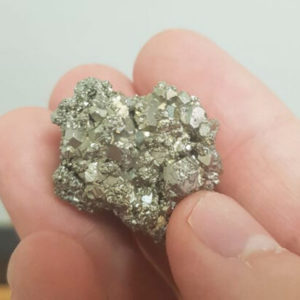You might be interested in
Mining
Monsters of Rock: MinRes has 'seen the bottom' in lithium prices, Lynas tightens the screws on rare earths supply
Mining
Rock chip revelation: New gold zone at Mako’s Tchaga North returns up to 76.10 g/t
Mining
Mining
Researchers from Curtin University have found tiny amounts of gold can be trapped inside pyrite – commonly called fool’s gold – meaning it could be more valuable than the name suggests.
The study, published in the Journal of Geology, analysed the mineralogical location of the trapped gold in pyrite, which could lead to more environmentally friendly extraction methods.
But don’t get too excited and start picking up pyrite just yet – you can’t see it with the naked eye. This type of gold is only observable using a fancy scientific instrument called an atom probe.

“Previously gold extractors have been able to find gold in pyrite either as nanoparticles or as a pyrite-gold alloy, but what we have discovered is that gold can also be hosted in nanoscale crystal defects, representing a new kind of ‘invisible’ gold,’ Curtin lead researcher Dr Denis Fougerouse said.
“The more deformed the crystal is, the more gold there is locked up in defects.”
“The gold is hosted in nanoscale defects called dislocations – one hundred thousand times smaller than the width of a human hair – so a special technique called atom probe tomography is needed to observe it.”
Dr Fougerouse said the team also explored extraction methods to obtain the trapped gold with less adverse impacts on the environment.
“Generally, gold is extracted using pressure oxidizing techniques (similar to cooking), but this process is energy hungry,” he said.
“We wanted to look into an eco-friendlier way of extraction.”
“We looked into an extraction process called selective leaching, using a fluid to selectively dissolve the gold from the pyrite.”
“Not only do the dislocations trap the gold, but they also behave as fluid pathways that enable the gold to be ‘leached’ without affecting the entire pyrite.”
Dr Fougerouse also noted that ores with invisible gold are now a common resource for the gold mining industry, and that further research into pyrite could lead to processing options tailored to optimise gold extraction.
He pointed to other studies of strained crystals in other mineral systems which indicate enhanced nonlinear dissolution in the presence of crystal defects such as dislocations – meaning pyrite dislocations enriched in gold could be more prone to dissolution than bulk crystal.
Essentially, this boils down to a reduction in the energy consumption necessary for extraction and an alternative method of selective (or in situ) leaching.